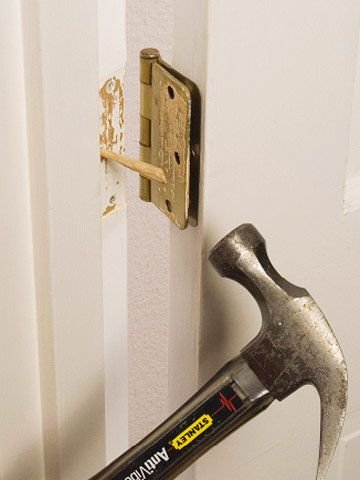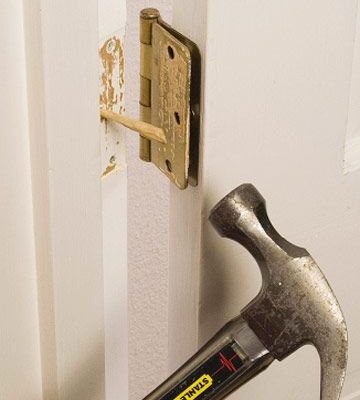
Here’s the thing: A gritty exterior door hinge isn’t just annoying. Letting it go can actually mess with how your door seals, make it harder to close, and even risk damage to the frame or lock over time. If you’ve never fixed one before, don’t stress. You don’t need to be a home repair pro or own a bunch of special tools. Let me walk you through what’s happening, why it matters, and—most importantly—how to fix that gritty hinge so your door glides smooth again.
Why Does An Exterior Door Hinge Feel Gritty?
A gritty feeling in a door hinge is usually a sign that something’s off inside the hinge’s moving parts. Exterior door hinges—from big names like Schlage right down to generic options—are designed to swing hundreds of times a year without trouble. But even the best hinges can start to feel rough for a few common reasons.
First, dirt and dust are the usual suspects. Every time you open or close your door, tiny particles can work their way into the gaps of the hinge. Over time, this grit builds up, making the hinge feel scratchy or stiff. Think of it as sandpaper stuck inside a machine—too much friction, not enough smooth motion.
Another big factor is lack of lubrication. Hinges need a thin layer of grease or oil to glide properly. Rain, wind, or even just time can dry it out. If you’ve had a humid week or salty air from living near the ocean, those elements can make things worse by causing rust or corrosion. That gritty feel is your hinge’s way of saying, “Hey, I need a little help here.”
You might be wondering if the issue is deeper—like something bent or damaged inside the hinge. While that’s possible, it’s usually less common unless your door has taken a hard hit or been slammed a lot. Most of the time, the culprit is simple: dirt, dryness, or rust.
How To Check If Your Door Hinge Is Really The Problem
Before you break out the tools or rush to buy a new hinge, it’s smart to confirm that the hinge itself is what’s causing the gritty trouble. Sometimes, what feels like a rough hinge could actually be another part of your door setup. Here’s how to check:
- Open and close the door slowly. Listen and feel for gritty resistance. Is the feeling coming from the hinge area, or is it somewhere else—like the lock or weatherstripping?
- Look closely at the hinge pins. If you notice rusty streaks, buildup, or dark powder where the two hinge plates meet, you’re likely dealing with a dirty or dry hinge.
- Gently lift the door while it’s open. If it wiggles a lot up and down, your hinges might be loose or worn out, which can also cause roughness.
- Inspect for rubbing. Make sure the edge of the door isn’t scraping directly against the frame or threshold. Sometimes friction there can feel like hinge trouble.
If most of the roughness seems to happen right at the hinge spots, congrats—you’ve found your gritty culprit. It’s always better to double-check before you start troubleshooting, just in case another part is to blame.
Common Causes Of Gritty Hinges On Exterior Doors
Let’s dig deeper into what causes that rough, sandy feel in your exterior door hinge. Understanding these triggers will help you prevent problems in the future, too.
- Dirt and debris: Outdoor doors see a lot of dust, pollen, and tiny bits of grit—especially if your home is near a busy road or you have pets running in and out. All that junk can work its way into the tiny spaces where your hinge rotates.
- Lack of lubrication: Hinges need oil or grease to run smoothly. Without it, the metal-on-metal contact grinds away, and things get scratchy fast.
- Rust and corrosion: Exterior hinges are generally made to resist weather, but moisture, salt air, or even just humid weather can cause rust. If you see orange or brown stains where the pin meets the plate, that’s a warning sign.
- Poor installation or wear: Sometimes, hinges aren’t installed quite right. If the hinge pin isn’t lined up, or if the screws are loose, there can be extra friction that wears down the hinge and leads to a gritty feel.
Honestly, most gritty hinges just need regular cleaning and a dab of oil to bounce back. But if you’ve got a rusty mess or a bent hinge, you may need to repair or replace it.
Step-By-Step: How To Fix A Gritty Exterior Door Hinge
Ready to tackle that rough hinge? Here’s a simple, beginner-friendly process you can follow—even if you’ve never touched a hinge before.
- Gather your tools: All you really need is a screwdriver, a hammer or mallet, a sturdy nail (or hinge pin punch), a rag, all-purpose cleaner, and lubricant (like WD-40 or white lithium grease).
- Pop out the hinge pin: Open the door wide so you have room to work. Place the nail under the hinge pin’s edge and tap upward with your hammer until it slides out. Go slow; don’t scratch up the door.
- Wipe down the parts: Use your rag and all-purpose cleaner to scrub away any visible grit, dust, or rust from both the pin and the hinge plates. If you spot stubborn rust, you can use steel wool or a soft brush to gently remove it.
- Lubricate everything: Spray or dab your lubricant onto the hinge pin and inside the hinge barrel. Don’t go overboard—a little goes a long way. Move the pin back and forth with your hand to be sure the lubricant covers everything.
- Reinstall the hinge pin: Slide the pin back in and tap it gently with the hammer. Open and close the door a few times to work in the lubricant and check for smooth motion.
If the door now swings quietly, you’ve nailed it! If it’s still a bit gritty, repeat the process or check for bent parts. Sometimes, severely rusted or damaged hinges just need to be replaced.
When To Replace Versus Repair Your Door Hinge
Here’s a question I hear a lot: *Should I just fix the old hinge, or is it time to swap it out for a new one?* Sometimes, a little elbow grease is all you need. But other situations call for a full replacement.
If your hinge is just dirty or dry, a thorough cleaning and some lubrication should do the trick. Most well-built hinges—think Schlage, Kwikset, or Yale—can last for years with minor upkeep. But if the hinge pin is badly bent, the barrel is cracked, or you see huge flakes of rust, it’s probably easier and safer to just replace the whole hinge.
Replacement is also smart if the screws aren’t holding tight (which can mean the wood around the screw holes is stripped), or if the hinge plate itself is warped. Fixing those by hand can be tricky and might not last. New hinges aren’t expensive, and swapping them out is often faster than trying to repair serious damage—especially if you’re dealing with a universal hinge that fits most exterior doors.
If in doubt, replacing a tired, rusted hinge now can save you way more hassle (and door alignment headaches) down the road.
Choosing The Right Lubricant For Your Exterior Door Hinge
You might be wondering: “Can I just squirt whatever oil I have on hand into my gritty hinge?” Not quite. Using the right product can make a big difference in how long your fix lasts.
- WD-40: This is a classic cleaner and lubricant that works well for breaking up grime and stopping squeaks. However, it can dry out over time, so it’s best to follow up with a real grease for lasting results.
- White lithium grease: This is your long-term, outdoor-safe option. It sticks to metal, resists rain, and doesn’t wash away easily—perfect for exterior hinges that face the elements.
- Silicone spray: If you want a cleaner option that won’t attract as much dust, silicone lubricants are good. They’re not quite as durable as grease, but they’re mess-free and don’t stain.
If you’re using a smart security door or a fancier brand, always double-check in the manual or on the manufacturer’s website for recommendations. Most standard steel or brass hinges are fine with the products above.
Preventing Gritty Hinges In The Future
Here’s the part that everyone forgets: proactive care. Once you’ve dealt with a gritty hinge, you probably never want to deal with it again. The good news? Preventing this problem is easier than fixing it—and takes barely any time.
- Check your door hinges every few months. Open the door, touch the hinge, and listen for any signs of roughness or squeaks. If it feels dry, add a dab of lubricant right away.
- Clean the hinge area regularly. Sweep away cobwebs, dust, or leaves that get caught around your exterior door. Less gunk means less grit working its way inside.
- Consider weatherproofing. If your door faces a lot of rain, salty air, or extreme humidity, you might want to swap for stainless steel or coated hinges, which resist rust better over time.
- Use a universal hinge lubricant for easy maintenance. These are designed to handle all types of exterior doors—no matter the brand or material.
Preventive care isn’t glamorous, but it can save you from wrestling with a stubborn, gritty hinge on a cold morning when you’re already running late.
Troubleshooting Other Door Problems That Feel Like Gritty Hinges
Here’s something that surprises a lot of people: not every “rough” door is actually a hinge problem. Sometimes, what *feels* like a gritty hinge is actually an issue with the door frame, latch, or even the lock mechanism—especially on modern smart door setups or older wooden entries.
For example, if your door is sticking or dragging at the bottom, there might be swelling in the wood or a shifted threshold—not a bad hinge. Or maybe the lock is catching because of misalignment, which can happen after years of use or if the screws holding your hinge have pulled loose. Sometimes, even a drained smart lock battery or a sticky keypad can cause enough resistance that it *feels* like a hinge is at fault.
If you’ve cleaned and oiled your hinges but the problem isn’t solved, try these checks:
- Inspect the strike plate on the frame. If it’s loose or bent, your door might not close smoothly.
- Check for swelling or warping in wooden doors—look for paint cracks or uneven gaps.
- Test the lock mechanism with and without the door closed. If it feels gritty both ways, the problem could be inside the lock, not the hinge.
Sometimes, fixing a “gritty hinge” is about seeing the bigger picture and making sure all the moving parts are happy—not just the hinges themselves.
Final Thoughts: Restoring a Smooth, Inviting Front Door
A gritty exterior door hinge might seem like a tiny annoyance, but honestly, it can mess with your whole entryway vibe—making your door feel older and harder to use. The good news is, most gritty hinges just need some simple care: a good cleaning, a dab of the right lubricant, and maybe a quick check to catch any deeper issues.
Taking five or ten minutes to fix up your hinges now can save you plenty of hassle (and awkward door noises) later, whether you’re rocking a sturdy Schlage, Yale, or any universal-fit exterior door setup. Keep those hinges happy, and your door will feel smoother, safer, and a lot more welcoming every time you come home.
